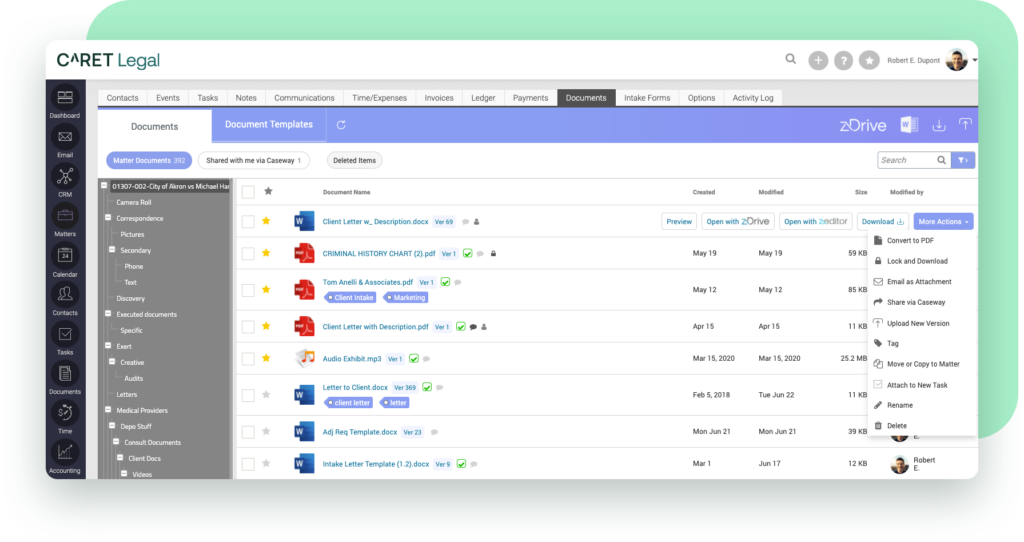By implementing robust organizational systems, leveraging advanced technology, and following best practices, your firm can transform its approach to discovery
By staying organized, leveraging technology, and applying proven workflows, your firm can manage discovery with greater efficiency and confidence.
Discovery can be a time-consuming process with the constant influx of electronic data and numerous data sources. But with the right systems and tools, legal teams can streamline workflows, reduce errors, and save time throughout the case preparation process.
More Electronic Data
As technology progresses, the volume of electronic data continues to increase. This includes not just emails and documents, but also text messages, images, videos, metadata, and other types of electronic data that need to be managed. Managing and reviewing such large volumes—often measured in terabytes—requires thoughtful approaches and tools. Legal teams today are dealing with far more digital content than the paper files of the past, requiring a more sophisticated method for handling it all. Initial Conferences are often conducted by Administrative Judges to determine the necessary steps in the data gathering process.
Multiple Data Sources
The types and locations of data have multiplied significantly. From traditional sources like email and documents to social media, cloud platforms, and even IoT devices, information is coming from all directions. This diversity makes it necessary to have a system that can track, gather, and organize a wide range of formats and sources. Each one presents its own set of challenges, such as access, formatting, and relevance. Legal professionals must be prepared to navigate this expanding data environment.
Tight Deadlines and Budget Constraints
Discovery is often limited by time and cost. Sorting through data, identifying what matters, and preparing for case deadlines can quickly become overwhelming. Budget pressures demand practical approaches to allocate resources effectively. Clients also expect efficient service and fast turnaround times. Traditional methods have been gradually replaced by more efficient techniques.
Courts expect diligence throughout the discovery process. Missteps—like missing relevant data or failing to meet deadlines—can lead to financial penalties or even case dismissal. This level of scrutiny makes it necessary to document each step and follow established protocols specifically.
Recognizing and managing these challenges is the starting point for staying organized during discovery.
How to Organize Your Discovery Requests
Organizing the discovery process is a critical step in ensuring the success of any legal case. It requires a methodical approach that combines strategic planning, systematic document management, and effective use of technology. By implementing a well-structured organization system, legal teams can significantly reduce the time and resources spent on discovery, minimize errors, and improve their ability to identify key information quickly. This section explores three fundamental aspects of organizing the discovery process: creating a comprehensive discovery plan, implementing an efficient coding system, and setting up a centralized repository.
Creating a Discovery Plan
A discovery plan outlines the overall direction of your efforts. It defines the scope, identifies which data matters to the case, and highlights where that data might be found. By having a clear outline from the start, legal teams can work more efficiently and avoid misalignment.
One of the first steps is identifying custodians—people or entities who may hold relevant data. These may include clients, opposing parties, or third-party service providers. By doing this early, you keep your focus and avoid missing important sources.
The plan also lays out timelines for each stage—from data collection through review and production. Clear milestones help keep work on track and aligned with court schedules. Breaking the work into smaller phases also makes it easier to allocate resources and manage progress.

Implementing a Coding System
A coding system organizes documents for fast and accurate retrieval. It includes file naming, tagging, and version tracking—tools that reduce time spent hunting for key materials and prevent documents from being misplaced.
A consistent naming convention makes it easy to identify document types, sources, or dates. Tagging adds another level of structure by grouping documents based on relevance, confidentiality, or subject matter. These tools make searching and filtering much more efficient.
Version tracking is also important. In collaborative environments, it’s common for multiple people to edit the same file. Version control helps teams work with the most up-to-date information and provides a reliable history of changes.
When implemented well, a coding system supports consistency and speeds up the review process.
Setting Up a Centralized Repository
A centralized document repository stores all discovery materials in one secure location. This includes original files, updated versions, and associated metadata. It acts as the single source of truth, reducing the risk of inconsistent or duplicated information.
The document management system you use should support advanced search, control access for different users, and log activity. It also needs to keep information secure, manage high volumes of data, and be easy to navigate.
The folder structure within the system should reflect your case strategy, helping team members quickly locate and collaborate on relevant files. A well-organized repository makes it easier for everyone to stay on the same page.
How to Use Technology for Discovery Organization
Modern legal work requires more than manual review. With larger datasets and tighter deadlines, the right tools can help legal teams work faster and smarter. Below are three technology solutions that can significantly improve discovery organization: e-discovery software, task management tools, and data analytics platforms.
E-Discovery Software
E-discovery platforms combine many aspects of the process into one system. They are designed to handle large volumes of documents and make review more efficient.
Advanced search functions—like Boolean and concept-based searching—help uncover important files even when exact terms aren’t used. This is especially useful in complex or technical cases where you need to request evidence during the discovery phase.
For example, e-discovery software can be used to analyze process variants in Total Cost of Ownership (TCO) scenarios, or to ensure compliance with privacy rights by limiting information gathered from individuals not involved in a particular case.
Optical Character Recognition (OCR) turns scanned images and PDFs into searchable content. This is helpful when reviewing older materials or files that weren’t created digitally.
A well-designed e-discovery platform should also integrate with your firm’s existing systems, allowing your team to adopt new tools without major disruptions to current workflows.
Task Management Tools
Task management tools let teams stay on top of deadlines, delegate responsibilities, and track progress across the discovery process. They simplify coordination, which is especially valuable when multiple people are handling different tasks.
These tools also support internal communication and productivity, helping team members clarify roles, share updates, and avoid duplication of work. Some platforms offer reporting features that let managers monitor productivity and adjust workloads as needed.
For fast-paced discovery work, these tools support accountability and improve visibility across the team.
Data Analytics and Visualization in Discovery Methods
Data analytics tools help uncover trends, patterns, or important connections within large datasets. They reduce time spent on manual review and provide more meaningful insights from the information collected.
Visualization tools help present data in clear, graphic formats—useful for client presentations, internal updates, or court filings. Visuals help make complex data more digestible and persuasive.
Predictive coding is another powerful feature. It uses machine learning to tag documents based on a sample review set, reducing the time it takes to categorize large volumes of material. These capabilities are becoming more accepted in legal settings, offering a more scalable way to manage discovery.
Best Practices for Day-to-Day Civil Discovery Management
Staying organized during discovery takes more than planning. It also involves managing your team’s communication, checking work for accuracy, and adjusting as new information comes in.
This section outlines three practical areas of focus: communication, quality control, and adapting to change.
Maintaining Clear Communication
Clear, ongoing communication helps teams stay coordinated. It prevents miscommunication and keeps the strategy unified throughout the process.
Holding regular team meetings helps review progress, troubleshoot issues, and clarify responsibilities. These check-ins are also a space for team members to share insights or raise questions, much like how a judge oversees the discovery process to ensure fairness and clarity.
Once a lawsuit is filed, maintaining open lines of communication becomes explicitly necessary to manage discovery schedules and the exchange of information.
Recording decisions and the reasons behind them adds transparency. It creates a reference point that supports consistency and can be helpful if you need to explain your strategy later to clients or the court.
Implementing Quality Control
Review protocols help maintain consistency. These guidelines explain what reviewers should be looking for, how to classify documents, and how to handle sensitive materials. They help ensure all reviewers follow the same standards.
Periodic spot checks allow supervisors to catch mistakes early. Sampling reviewed documents can reveal tagging issues or inconsistencies, helping improve the process.
Conflict checks and privilege screens protect sensitive information. These safeguards help prevent accidental disclosures and uphold legal and ethical obligations.
Adapting to New Information
Discovery is often unpredictable. New documents, custodians, or facts may arise mid-process. Being able to incorporate these developments without disrupting the entire system is a valuable skill.
You may need to adjust naming conventions, search terms, or tagging categories. Revisiting your discovery plan can help determine if timelines or resource allocations need to shift.
Managing scope is also important. Not all new data needs to be included. Being selective about what’s relevant helps avoid unnecessary work and added costs.
Take Your Discovery to the Next Level
Developing strong discovery habits takes time—but the long-term benefits are substantial. With the right systems, tools, and workflows, your firm can manage discovery with greater clarity, fewer errors, and more predictable outcomes.
An organized discovery process leads to more efficient operations and better client service. You’ll not only meet expectations—you’ll be better equipped to exceed them.
Ready to bring structure to your discovery process? Try a free trial of CARET Legal today and see how seamless discovery can be.
